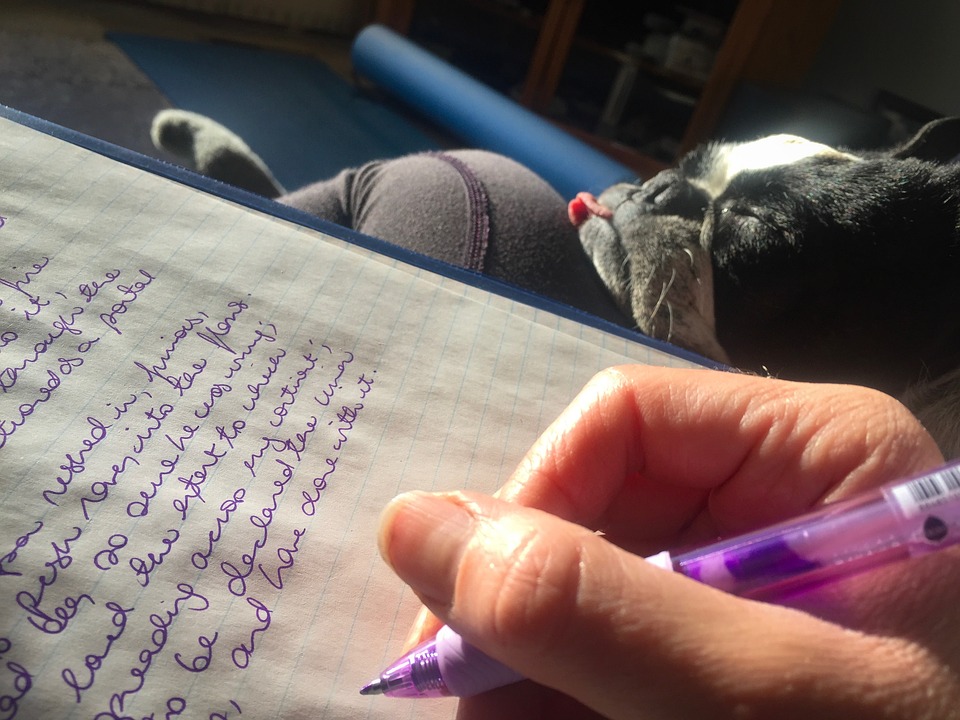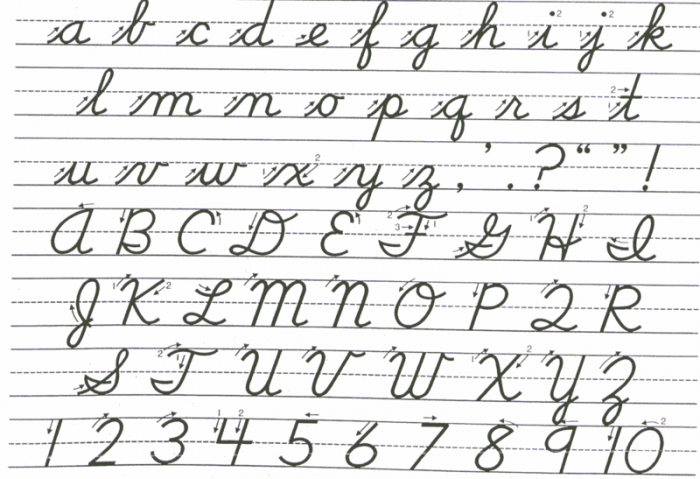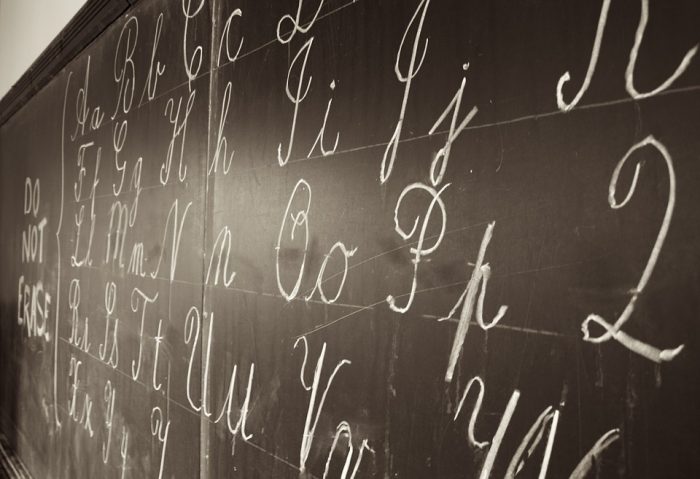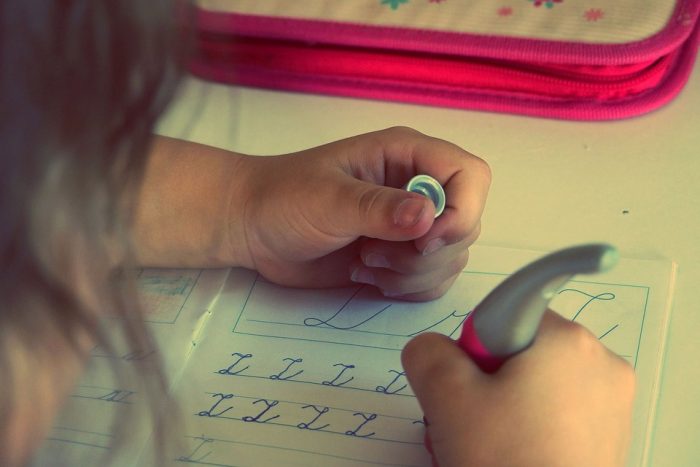What Quills Are Dipped in

Are y'all interested in learning to write all the capital letter cursive letters, from A to Z? This article will show you how to write all the capital cursive letters as well equally discuss some interesting facts about cursive.
The listing of capital cursive letters below will help you get acquainted with uppercase cursive letters. You'll want to get over each of the messages in this list thoroughly and exercise them daily until y'all can join them together with no problems.

Photo: "Cursive" (https://pt.wikipedia.org/wiki/Ficheiro:Cursive.png) past helix84 via Wikimedia Commons, released to Public Domain (https://en.wikipedia.org/wiki/public_domain)
Why Acquire Cursive?
Perhaps you lot are wondering: why learn cursive at all? The main statement given for becoming expert in cursive writing is that, compared to writing in print, writing in cursive lets ane write faster and more than efficiently.
Cursive letters have joins, parts of the character that links them together with other characters, enabling a quicker writing speed. When writing in impress, one has to lift their writing implement far more than often than writing when in cursive. In addition, it is argued that precisely considering fewer people are writing in cursive, writing in cursive may cause people to take you more seriously and grant you gravitas.
While of the common grade of cursive that near people write in has joined linking letters together, not all types of cursive have these joins. There are at least three dissimilar varieties of cursive: looped cursive, italic cursive, and ligature cursive. Looped cursive is what well-nigh people envision when the word "cursive" is sad, the looping course of writing that has ascenders and descenders and links letters together.
Another type of cursive writing is ligature cursive, which is singled-out from other types of cursive. Ligatures possess joins between letters, significant that 1 tin write quicker in comparison to press, some older texts that use ligature refer to the smaller letters within the font every bit "cursive" though in this instance the letters aren't actually joined together. Italic cursive is a form of writing that uses no joins or in some cases, non-looped joins. The term italic cursive gets its name from the fact that it was used in the 15th century in Renaissance Italy, and it should not be dislocated with italic letters in typefaces, which simply means that the letters are slanted. In italic cursive, there are no joins that link the letters Y, G, Q, and J together.
Where Does "Cursive" Originate?
The term cursive is typically said to be derived from a Latin word – "corsivo". This means "to run" or "running". As for the development of the cursive writing manner, the connection of letters together in a flowing way, various cultures throughout history have utilized connected writing styles. Various Roman forms of writing used connected letters, as did many Arabic writing styles. The style of cursive that is used to write English language is the development of a writing style developed during the 17th century in Western Europe. Over the 17th and 18th centuries, this cursive style evolved and become more widely adopted, eventually receiving standardizations that made it the new template for writing the English language. The style of cursive used in the US today has been around since the days of the US colonies, with various revisions hither and there.

Photo: (https://pixabay.com/photos/blackboard-writing-chalk-white-209152/) past kyasarin via Pixabay, Pixabay License (https://pixabay.com/service/license/)
Much every bit print has different writing styles and fonts, cursive has different standardized versions too. The cursive style that most people apply today is based on the D'Nealian script, which is itself derived from an older cursive teaching method called the Palmer method/Palmer script. In the late 1970s, the schoolteacher Donald Thurber adapted the Palmer method, making various tweaks to it to create the D'Nealian script. Thurber wanted to make learning both print and cursive writing easier, and he argued that previous didactics styles and scripts made the transition between print to cursive more difficult, as there were substantial changes in the manner the messages were taught. Therefore, Thurber created the D'Nelian script with the goal of using standards for print and cursive that would make the transition between the two writing forms easier.
It isn't clear that the D'Nealian genuinely facilitates the learning of print and cursive writing styles, as a research review was done in 1993 past Prof. of Literacy at Vanderbilt University Stephen Graham found picayune to no testify that D'Nealian script actually made the learning of writing easier or children's writing noticeably better.
Cursive is beingness challenged as a legitimate style to allocate limited school instruction fourth dimension in recent years, as the increasing adoption of digital communication methods and keyboards have made cursive unnecessary according to some.
Is Cursive Writing All the same Relevant?
While the proliferation of digital communication has called the practicality of cursive into question, this isn't the first time in history that cursive'southward utility has been challenged. Different technological improvements over the years take likewise challenged the necessity of cursive writing, including the invention of the ballpoint pen.
One of the principal reasons for learning to use cursive, or then information technology is often said, is that writing with ink quills was simpler when using a cursive writing mode. When writing in cursive, the quill did not need to be lifted and re-dipped in ink every bit frequently as when writing in print, as the human action of lifting the quill would cause the ink to dry quicker. As ballpoint pens became easier to produce and more than reliable, cursive's utility began to turn down. This decline in usage was too contributed to by subsequently inventions such as the typewriter, as well as the computer and the reckoner keyboard.

(https://pixabay.com/photos/students-computer-young-boy-99506/) via cherylt23, Pixabay License(https://pixabay.com/service/license/)
Through the 1950s and 1960s in the Us, cursive was widely taught and was the dominant method of writing. In the years since then, many educational analysts, scientists, and teachers accept argued that education cursive is a waste of limited instruction time, specially given the increasing proportion of communication done digitally in the 21st century. Various studies have suggested that cursive'due south use is on the decline. Equally far dorsum as 2007, a study at the time found that although 90% of all third-graders and around one-half of second-graders in the Us were taught in cursive, but some xv% of high schoolhouse students would answer their SATs in a cursive. Throughout the 2000s and 2010s, school districts in states like Indiana and Hawaii have ceased mandating cursive instruction in their school curriculums, replacing them with keyboard proficiency and digital communication instruction to reflects the growing usage of these technologies.
The Common Cadre standards of education exit the educational activity of cursive upwardly to individual states and schoolhouse districts, making no mandate about cursive instruction. Individual states go to determine if instruction cursive is worth their time, and many states in the Usa have decided against information technology. One report released past the Miami-Dade public school system found that schoolhouse districts across the land have been slowly but surely ceasing cursive instruction. This tendency even seems to use to other countries, as Finland has as well recently elected to terminate the mandated educational activity of cursive.
Those who yet argue for teaching cursive in schools claim that cursive is notwithstanding relevant to history and advice, making the argument that many important historical documents are written in diverse types of cursive, and without training in cursive future historians will be able to appreciate these documents in the form that they were written. This is ane reason that some historians and teachers argue for the preservation of cursive didactics in school curriculums. However, though historians may take a apply for learning cursive, the rest of society may non need to. Counter-arguments to cursive'southward utility say that most people living in the 21st century will non need to learn cursive.

(https://pixabay.com/photos/child-kid-writing-homework-messages-2619902/) via Pixabay, Pixabay License (https://pixabay.com/service/license/)
Other arguments for the preservation of cursive in school curriculums state that learning cursive makes the handwriting of students ameliorate, encouraging legible and clear writing and communication. It has even been argued that learning cursive makes students superior writers and readers on the whole, able to process written textile more efficiently and write quicker. Some studies seem to back up the thought that writing notes by paw, in comparison to taking notes on a figurer, engenders superior recall and comprehension of textile. In that location as well seems to be some credible prove that teaching cursive could enable students with linguistic communication disabilities such as dyslexia read and write better.
Nonetheless it isn't entirely obvious that writing in cursive is the phenomenon responsible for improved recollect or comprehension of textile. It could be that simply the act of writing fabric down, of writing out words in any physical format rather than a digital format, is responsible for increased material comprehension.
Those in favor of dropping cursive from school curriculums reply to claims of cursive's benefits with arguments that at that place is little evidence which supports the notion that cursive genuinely enhances 1'due south reading or writing abilities. In addition, information technology is argued that reported benefits of writing in cursive may simply be an example of confirmation bias, that the improvements in reading and writing may come from other miracle and are simply attributed to cursive. Another criticism is that studies which claimed to observe associations between enhanced material recall and cursive writing accept been either misrepresented or misinterpreted.
No matter how you feel nearly cursive instruction in schools, if y'all personally are interested in writing in cursive, y'all need to practice it daily until you take mastered the messages. Offset by obtaining a listing of all cursive characters, both lowercase and uppercase characters, and keep practicing them until you can write them perfectly without error.
Source: https://sciencetrends.com/cursive-capital-letters-from-a-to-z/

0 Response to "What Quills Are Dipped in"
Post a Comment